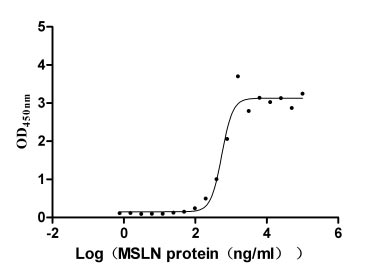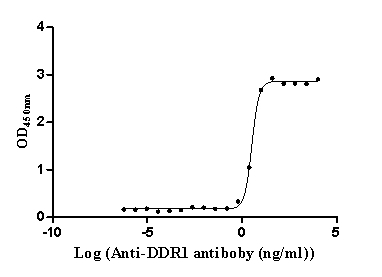Recombinant Rat Synapsin-1 (Syn1)
-
货号:CSB-YP023002RA
-
规格:
-
来源:Yeast
-
其他:
-
货号:CSB-EP023002RA
-
规格:
-
来源:E.coli
-
其他:
-
货号:CSB-EP023002RA-B
-
规格:
-
来源:E.coli
-
共轭:Avi-tag Biotinylated
E. coli biotin ligase (BirA) is highly specific in covalently attaching biotin to the 15 amino acid AviTag peptide. This recombinant protein was biotinylated in vivo by AviTag-BirA technology, which method is BriA catalyzes amide linkage between the biotin and the specific lysine of the AviTag.
-
其他:
-
货号:CSB-BP023002RA
-
规格:
-
来源:Baculovirus
-
其他:
-
货号:CSB-MP023002RA
-
规格:
-
来源:Mammalian cell
-
其他:
产品详情
-
纯度:>85% (SDS-PAGE)
-
基因名:
-
Uniprot No.:
-
别名:Syn1; Synapsin-1; Synapsin I
-
种属:Rattus norvegicus (Rat)
-
蛋白长度:Full length protein
-
表达区域:1-704
-
氨基酸序列MNYLRRRLSD SNFMANLPNG YMTDLQRPQP PPPPPSAASP GATPGSAAAS AERASTAAPV ASPAAPSPGS SGGGGFFSSL SNAVKQTTAA AAATFSEQVG GGSGGAGRGG AAARVLLVID EPHTDWAKYF KGKKIHGEID IKVEQAEFSD LNLVAHANGG FSVDMEVLRN GVKVVRSLKP DFVLIRQHAF SMARNGDYRS LVIGLQYAGI PSVNSLHSVY NFCDKPWVFA QMVRLHKKLG TEEFPLIDQT FYPNHKEMLS STTYPVVVKM GHAHSGMGKV KVDNQHDFQD IASVVALTKT YATAEPFIDA KYDVRVQKIG QNYKAYMRTS VSGNWKTNTG SAMLEQIAMS DRYKLWVDTC SEIFGGLDIC AVEALHGKDG RDHIIEVVGS SMPLIGDHQD EDKQLIVELV VNKMTQALPR QRDASPGRGS HSQTPSPGAL PLGRQTSQQP AGPPAQQRPP PQGGPPQPGP GPQRQGPPLQ QRPPPQGQQH LSGLGPPAGS PLPQRLPSPT AAPQQSASQA TPMTQGQGRQ SRPVAGGPGA PPAARPPASP SPQRQAGPPQ ATRQASISGP APPKVSGASP GGQQRQGPPQ KPPGPAGPIR QASQAGPGPR TGPPTTQQPR PSGPGPAGRP TKPQLAQKPS QDVPPPIIAA AGGPPHPQLN KSQSLTNAFN LPEPAPPRPS LSQDEVKAET IRSLRKSFAS LFSD
-
蛋白标签:Tag type will be determined during the manufacturing process.
The tag type will be determined during production process. If you have specified tag type, please tell us and we will develop the specified tag preferentially. -
产品提供形式:Lyophilized powder
Note: We will preferentially ship the format that we have in stock, however, if you have any special requirement for the format, please remark your requirement when placing the order, we will prepare according to your demand. -
复溶:We recommend that this vial be briefly centrifuged prior to opening to bring the contents to the bottom. Please reconstitute protein in deionized sterile water to a concentration of 0.1-1.0 mg/mL.We recommend to add 5-50% of glycerol (final concentration) and aliquot for long-term storage at -20℃/-80℃. Our default final concentration of glycerol is 50%. Customers could use it as reference.
-
储存条件:Store at -20°C/-80°C upon receipt, aliquoting is necessary for mutiple use. Avoid repeated freeze-thaw cycles.
-
保质期:The shelf life is related to many factors, storage state, buffer ingredients, storage temperature and the stability of the protein itself.
Generally, the shelf life of liquid form is 6 months at -20°C/-80°C. The shelf life of lyophilized form is 12 months at -20°C/-80°C. -
货期:Delivery time may differ from different purchasing way or location, please kindly consult your local distributors for specific delivery time.Note: All of our proteins are default shipped with normal blue ice packs, if you request to ship with dry ice, please communicate with us in advance and extra fees will be charged.
-
注意事项:Repeated freezing and thawing is not recommended. Store working aliquots at 4°C for up to one week.
-
Datasheet :Please contact us to get it.
相关产品
靶点详情
-
功能:Neuronal phosphoprotein that coats synaptic vesicles, binds to the cytoskeleton, and is believed to function in the regulation of neurotransmitter release.
-
基因功能参考文献:
- The synapsin 1 in the insular cortex as a part of pathophysiological process that determines predisposition of Krushinsky-Molodkina rats to audiogenic seizures. PMID: 26923581
- SUMOylation of synapsin Ia (SynIa) at K687 is necessary for SynIa function. Replacement of endogenous SynIa with a non-SUMOylatable mutant decreases the size of the releasable vesicle pool and impairs stimulated SV exocytosis. PMID: 26173895
- Results suggest a mechanism of A2aR modulation of neurotransmitter release in cultured cells from medulla oblongata and suggest that protein kinase A mediates this modulation of neurotransmitter release via synapsin I phosphorylation PMID: 24912137
- rSynI(1.0)-minCMV drives robust and neuron-specific transgene expression throughout the CNS and is therefore useful for viral vector-mediated neuron-specific gene delivery and generation of neuron-specific transgenic animals. PMID: 24361760
- This study demonistrated that Increased activation of synapsin 1 in the amygdala of maternal separation rats. PMID: 24279756
- O-GlcNAcylation of Thr-87 interferes with folding of the ALPS motif, providing a means for regulating the association of synapsin I with SVs as a mechanism contributing to synapsin I localization and RPSV generation. PMID: 24280219
- The mean brightness of Syn1 per unit area of the dendritic tree of neurons changes over the estrous cycle, being approximately 35% lower at diestrus than at the remaining phases of the estrous cycle. PMID: 21948316
- A hybrid peptide consisting of synapsin carboxyl domain fused with E coli enterotoxin B subunit up-regulates expression of anti-inflammatory cytokines and diminishes myelin basic protein-specific T-helper cell responses in lymph nodes. PMID: 22138356
- Syn I phosphorylation at site 1 regulates synapse formation. PMID: 22045728
- Data provide a complete molecular pathway (GR/Egr-1/MAPK/Syn-Ia/Ib) through which stress and glucocorticoids enhance the memory of stress-related events and highlight the function of synapsin-Ia/Ib as molecular effector of the behavioral effects of stress PMID: 20368707
- Data show that Src-mediated tyrosine phosphorylation of synapsin I increases its binding to synaptic vesicles and actin, and increases the formation of synapsin dimers, which are both potentially involved in vesicle clustering. PMID: 20530578
- Data suggest that integrin-linked kinase exerts pleiotropic actions by regulating pre- and postsynaptic neural plasticities in response to repeated cocaine exposure through PSD-95 and synapsin I expression and GluR1 Ser845 phosphorylation. PMID: 19629758
- Either C-terminal domain E or a peptide derived from domain C was necessary and sufficient to inhibit both dimerization and vesicle clustering, indicating the participation of both domains in these activities of synapsin I. PMID: 19922412
- Seven days after fluid-percussion brain injury, synapsin I mRNA levels increase ipsilaterally and decrease contralaterally in the occipital cortex. PMID: 12184851
- These results raise the possibility that Ser(603) on synapsin I is alternatively phosphorylated by p21-activated kinases, not only by CaMKII, in neuronal cells in response to some stimulants. PMID: 12237306
- BEMAD methodology was validated by mapping three previously identified O-GlcNAc sites, as well as three novel sites, on Syn I. PMID: 12438562
- multiple signaling pathways serve to allow synapsin's control of vesicle mobilization over different stimulus frequencies. PMID: 12691665
- Time-dependent translocational changes of Synapsin I were investigated in regenerating axonal sprouts. PMID: 14612614
- Calorimetric measurements of ATP binding to wild-type and mutant recombinant Synapsin I-ABC demonstrate that the multifunctional loop and a cross-tetramer contact are important for ATP binding PMID: 14688264
- During the first postnatal week,synpsin 1 immunoreactive strongly concentrated in the Purkinje cell layer.By P14, synapsin 1 localized to many small puncta in the ML and to large clusters at mossy fiber rosettes in the glomerular layer. PMID: 15246689
- glucose-dependent actions of ERK1/2 in beta-cells exerted on cytoplasmic proteins, includes synapsin I and participates in the overall glucose-induced insulin secretion. PMID: 15498890
- In conclusion, this is the first evidence to show that PLD1 acts as an important regulator of neurite outgrowth in neural stem cell by promoting neuronal differentiation via increase of synapsin I expression. PMID: 15752728
- findings show that synapsin I plays a central role in regulating the organization and dynamics of synaptic vesicles in growth cones and that this activity is modulated by cAMP-dependent phosphorylation of the protein PMID: 16093379
- Neither haloperidol nor the dopamine-D1 receptor antagonist affected synapsin I protein expression. PMID: 16413126
- These results suggest, therefore, that Ca2+ entrance mediated by P2X7 receptor induces glutamate release and in parallel synapsin-I phosphorylation. PMID: 18242779
- Synapsin1a modulation by piccolo regulates synaptic vesicle exocytosis PMID: 18519737
- Data suggest that diabetes has a profound impact on synapsin I and other presynaptic protein expression in the retina, and may provide a mechanism for the well-established defects in vision and the electrophysiological response of the retina in diabetes. PMID: 18662330
- Synapsin I is embedded in open chromatin in R28 retinal precursor cells. PMID: 18692536
- Data show that long-term amygdala kindling increases synapsin I immunoreactivity bilaterally in most hippocampal subfields, but not in the caudate nucleus, sensorimotor cortices, or piriform cortex in rats. PMID: 18703092
- pentachlorophenol exposure during development causes thyroid function vulnerability, testicular hypertrophy in adults, and aberrations of brain gene expression of syn1 PMID: 19082768
- mW/cm(2) (SAR 14.1 W/kg) microwave radiation can result in the perturbation of the synaptic vesicles associated proteins: synapsin I, synaptophysin, VAMP-2, and syntaxin PMID: 19603498
显示更多
收起更多
-
亚细胞定位:Cell junction, synapse. Golgi apparatus.
-
蛋白家族:Synapsin family
-
数据库链接:
KEGG: rno:24949
STRING: 10116.ENSRNOP00000014250
UniGene: Rn.9923
Most popular with customers
-
Recombinant Human Mucin-16 (MUC16), partial (Active)
Express system: Mammalian cell
Species: Homo sapiens (Human)
-
Recombinant Human Epithelial discoidin domain-containing receptor 1 (DDR1), partial (Active)
Express system: Mammalian cell
Species: Homo sapiens (Human)
-
Recombinant Human Claudin-4 (CLDN4)-VLPs (Active)
Express system: Mammalian cell
Species: Homo sapiens (Human)
-
Recombinant Macaca fascicularis CD44 antigen (CD44), partial (Active)
Express system: Mammalian cell
Species: Macaca fascicularis (Crab-eating macaque) (Cynomolgus monkey)
-
Recombinant Human Microtubule-associated protein tau (MAPT) (Active)
Express system: Mammalian cell
Species: Homo sapiens (Human)
-
Recombinant Human Complement component C1q receptor (CD93), partial (Active)
Express system: Mammalian cell
Species: Homo sapiens (Human)
-
Recombinant Human Glucagon-like peptide 1 receptor (GLP1R), partial (Active)
Express system: Mammalian cell
Species: Homo sapiens (Human)
-
Recombinant Human Interleukin-2 receptor subunit alpha (IL2RA), partial (Active)
Express system: Mammalian cell
Species: Homo sapiens (Human)






-AC1.jpg)













